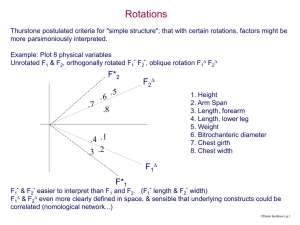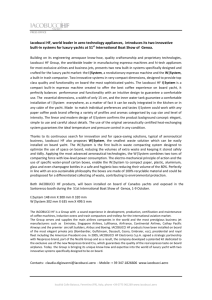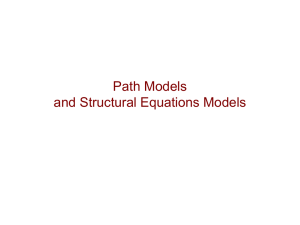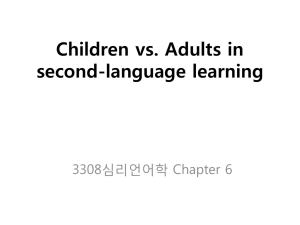Factor Analysis
advertisement
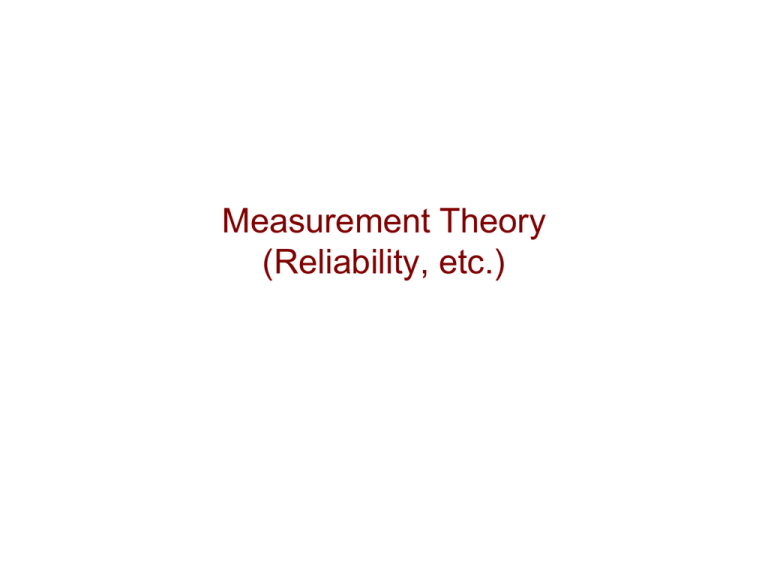
Measurement Theory (Reliability, etc.) Measurement Theory Books • • • • • Allen Mary J. and Wendy M. Yen (1979; 2002), Introduction to Measurement Theory, Prospect Heights, IL: Waveland Press. Anastasi, Anne (1982), Psychological Testing 5th ed., NY: Macmillan. Cronbach, Lee J. (1984), Essentials of Psychological Testing 4th ed., NY: Harper & Row. Ghiselli, Edwin E., John P. Campbell, and Sheldon Zedeck (1981), Measurement Theory for the Behavioral Sciences, San Francisco: Freeman. Nunnally, Jum C. and Ira H. Bernstein (1995), Psychometric Theory 3rd ed., NY: McGraw-Hill. Coefficient Alpha (Reliability) • • • Duhachek, Adam, Anne T. Coughlan and Dawn Iacobucci (2005), “Results on the Standard Error of the Coefficient Alpha Index of Reliability,” Marketing Science, 24 (2), 294-301. Duhachek, Adam and Dawn Iacobucci (2004), “Alpha’s Standard Error (ASE): An Accurate and Precise Confidence Interval Estimate,” Journal of Applied Psychology, 89 (5), 792-808. Iacobucci, Dawn and Adam Duhachek (2003), “Advancing Alpha: Measuring Reliability with Confidence,” Journal of Consumer Psychology, 13 (4), 478-487. Measurement—Miscellaneous Topics • • Spector, Paul E. (1992), Summated Rating Scale Construction: An Introduction, Newbury Park, CA: Sage. Wainer, Howard (1990), Computerized Adaptive Testing: A Primer, Hillsdale, NY: Erlbaum. Factor Analysis Factor Analysis: Intros • Iacobucci, Dawn (1994). “Classic Factor Analysis,” in Richard Bagozzi (ed.), Principles of Marketing Research, Cambridge, MA: Blackwell, 279-316. Inspired, what can I say. If you can’t find it, email me and I’ll send you a copy. Great intros: • Kim, Jae-On, and Charles W. Mueller (1978), Introduction to Factor Analysis: What It Is and How to Do it, Beverly Hills, CA: Sage. • Kim, Jae-On, and Charles W. Mueller (1978), Factor Analysis: Statistical Methods and Practical Issues, Beverly Hills, CA: Sage. Also good intros: • Comrey, Andrew L. and Howard B. Lee (1992), A First Course in Factor Analysis, 2nd ed., Hillsdale. NJ: Erlbaum. • Cooper, John C. B. (1983), “Factor Analysis: An Overview,” The American Statistician, 37 (2), 141-147. • Cliff, Norman (1987), Analyzing Multivariate Data, San Diego: Harcourt Brace Jovanovich. • Gorsuch, Richard L. (1983), Factor Analysis 2nd ed., Hillsdale, NJ: Erlbaum. Factor Analysis: “Confirmatory,” “Maximum Likelihood,” and “Statistical” From the master: • Joreskog, K. G. (1967), “Some Contributions to Maximum Likelihood Factor Analysis,” Psychometrika, 32, 443-82. • Joreskog, K. G. (1969), “A General Approach to Confirmatory Maximum Likelihood Factor Analysis,” Psychometrika, 34, 183-202. Easier to read: • Long, J. Scott (1983), Confirmatory Factor Analysis, Newbury Park, CA: Sage. Harder to read: • Basilevsky, Alexander (1994), Statistical Factor Analysis and Related Methods: Theory and Application, NY: Wiley. • Lawley, D. N. and A. E. Maxwell (1971), Factor Analysis as a Statistical Method, NY: Elsevier. • Topic also treated in Harman, Harry H. (1976), Modern Factor Analysis, U of Chicago Press, pp.197-206. Factor Analysis: Ancient, er, “Historical” • • • Harman, Harry H. (1976), Modern Factor Analysis, Chicago: The University of Chicago Press. Mulaik, Stanley A. (1972), The Foundations of Factor Analysis, NY: McGraw-Hill. (Still a fabulous read, if you can find a copy.) Thurstone. L. L. (1947), Multiple Factor Analysis, Chicago: University of Chicago Press. Factor Analysis: Advanced Topics • • • • Jones, Lawrence, and Dawn Iacobucci (1989), “The Structure of Affect and Trait Judgments of Political Figures, Multivariate Behavioral Research, 24, 457-76. (contains a higher-order factor analysis) Tucker, Ledyard (1966), “Some Mathematical Notes on Three-Mode Factor Analysis,” Psychometrika, 31, 279-311. (the source of the multi-mode factor analysis) Campbell, Donald T. and D. W. Fiske (1959), “Convergent and Discriminant Validation by the Multitrait-Multimethod Matrix,” Psychological Bulletin, 56, 86-105. MacCallum, Robert C., Keith F. Widaman, Shaobo Zhang and Sehee Hong (1999), “Sample Size in Factor Analysis,” Psychological Methods, 4 (1), 84-99. Factor Analysis: Advanced Topics continued #Factors: • Cliff, Norman (1988), “The Eigenvalues-Greater-than-One Rule and the Reliability of Components,” Psychological Bulletin, 103, 276-279. • Humphreys, LIoyd, and Daniel R. Ilgen (1969), “Note on a Criterion for the Number of Common Factors,” Educational and Psychological Measurement, 29, 571-578. • Montanelli, Jr., Richard G. and Lloyd G. Humphreys (1976), “Latent Roots of Random Data Correlation Matrices with Squared Multiple Correlations on the Diagonal: A Monte Carlo Study,” Psychometrika, 41, 341-8. Factor analysis smacks down principal components: • Humphreys, Lloyd G. and Randolph K. Park (1981), “Analysis of Variances and Covariances is Misleading as a Guide to a Common Factor Model,” Intelligence, 5, 157-163. • Snook, Steven C. and Richard L. Gorsuch (1989), “Component Analysis versus Common Factor Analysis: A Monte Carlo Study,” Psychological Bulletin, 106, 148-54. • Velicer, W. F., A. C. Peacock, and D. N. Jackson (1982), “A Comparison of Component and Factor Patterns: A Monte Carlo Approach,” Multivariate Behavioral Research, 17, 371-88.
